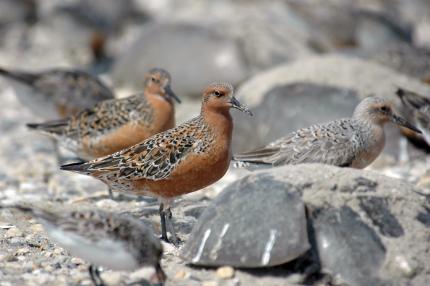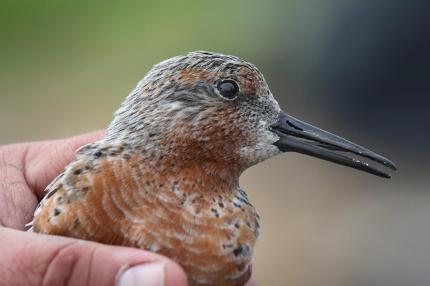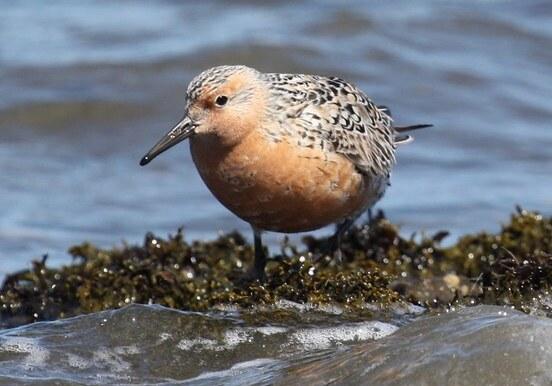Moderate-
High
The population size of red knots is low. Limited information suggests the population has declined. This species' localized use of food resources in tidal areas along the flyway suggests it will be sensitive to climate change effects.
Red knots of the subspecies roselaari are found in Washington in May, during the spring migration.
Description and Range
Physical description
The red knot is a stocky-looking bird that is about 10 inches in length. Breeding plumage is a rust colored face, breast, and underside and with dark mottling above. Winter plumage is pale gray with a white underside. Juvenile plumage is similar to winter but with scalloped feathering on the wings and back and with a light beige underside.
Ecology and life history
Red knots roost primarily on sand islands and low marsh shorelines, but they also use sand spits, and rarely sandy beaches or pastures in or near estuaries.
Primary foraging habitats include estuarine intertidal mud and sand flats; they will occasionally forage in pastures adjacent to estuaries during high tide. Red knots are known to consume a variety of invertebrates, but they are considered bivalve specialists.

Red knots of the subspecies roselaari are found in Washington, chiefly during spring migration. Spring migration occurs primarily in May.
Red knots nest in Arctic and sub-arctic tundra where nests are situated on the ground.
Geographic range
The species is very local in its distribution, both in Washington and elsewhere along the flyway. It is found on the outer coast, almost exclusively in Willapa Bay and Grays Harbor; these sites are major stopovers along the Pacific Flyway and likely support a large proportion of the population.
The population estimate in coastal Washington is about 17,000, making roselaari the least common of six global subspecies and one of the least common sandpipers to use the Pacific Flyway as its primary flyway. This subspecies breeds in northwestern Alaska and Wrangel Island, Russia and overwinters primarily at coastal locations in northwestern Mexico.
Limited information suggests a decline in abundance in the last 35 years. Most autumn migrants bypass Washington; they are very rare in summer and winter, and in any season away from the outer coast.
For a map of worldwide distribution and other species' information, see NatureServe Explorer and the International Union for Conservation of Nature Red List.
Climate vulnerability
Sensitivity to climate change
Moderate-
High
Red knots are unlikely to have direct physiological sensitivity to changes in climate during their migration through Washington. However, their overall sensitivity will be higher due to their habitat and foraging requirements. Prime foraging areas, like mudflats, may decline due to sea level rise and coastal flooding of these habitats. Additionally bivalve populations, a major source of prey, may experience declines due to ocean acidification as well as changes in period of tide flat exposure and area of tide flat exposure. Preferred roosting sites, like sand islands and marshes, may also become more limited due to rising sea level and/or increased storminess. In particular, changes in temperature leading to migration timing mismatches (i.e., timing of departure and arrival to coincide with favorable food, habitat and weather conditions) will [may] negatively affect this species.
Exposure to climate change
Moderate-
High
- Timing mismatches in favorable food, habitat, and weather conditions
- Sea level rise
- Declines in pH
- Increased storminess
Conservation
Conservation Threats and Actions Needed

- Resource information collection needs
- Threat: Population appears to have declined; more information needed to assess risks, vulnerability, and population status.
- Action Needed: Collect information to address threats.
- Fish and wildlife habitat loss or degradation
- Threat: Oil spill that impacts foraging area and fouls foraging birds.
- Action Needed: Spill response effectiveness.
- Invasive and other problematic species and genes
- Threat: Spartina removal has been successful, but tideflat elevation has increased due to trapped sediments. This may have altered food resources.
- Action Needed: Investigate food habits and prey availability; conduct experiments to restore tideflats to former elevation.
See the Climate vulnerability section for more information about the threats posed by climate change to the red knot.
Resources
References
Chappell, C. B. 2005. Red Knot (Calidris canutus). Pp 152-153 in Wahl, T. R., B. Tweit, and S. G. Mlodinow (Eds.), Birds of Washington: status and distribution. Oregon State University, Corvallis, OR, USA. 436 pp.
Harrington, B. A. 2001. Red Knot (Calidris canutus). The Birds of North America 563:1-32.
